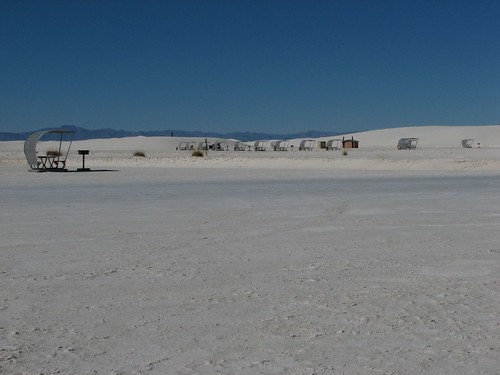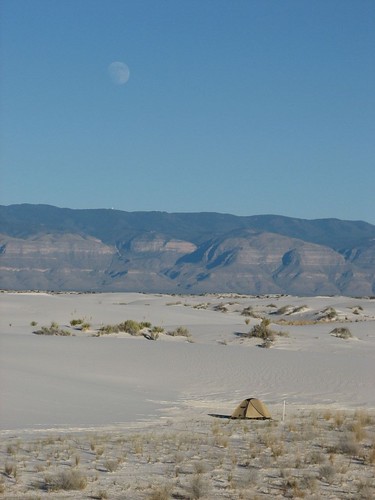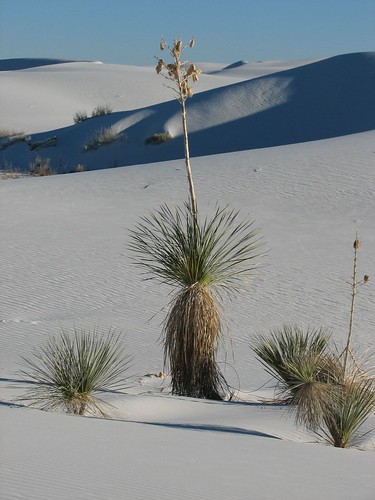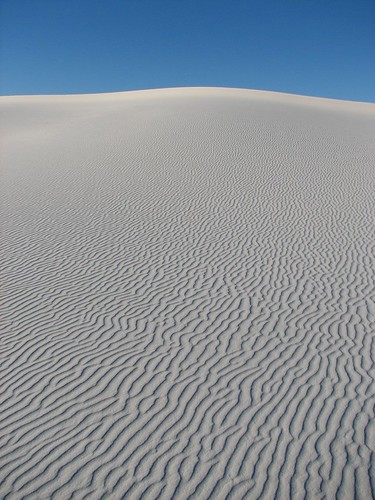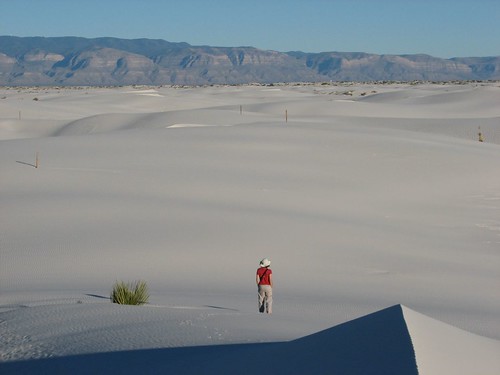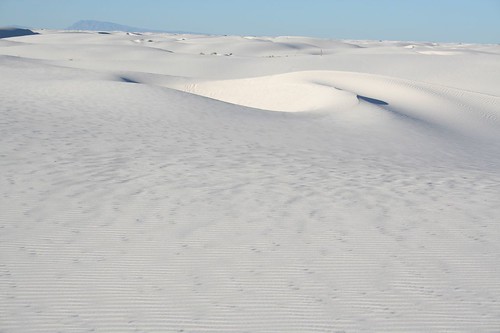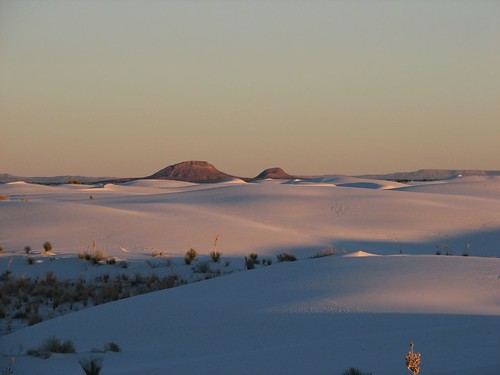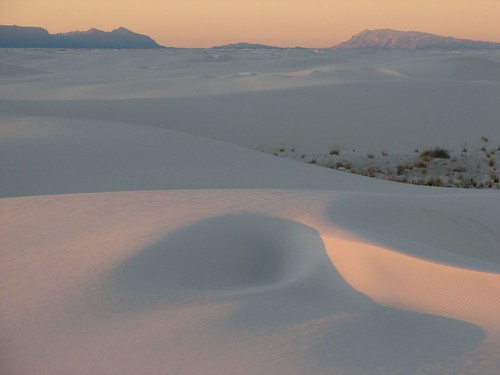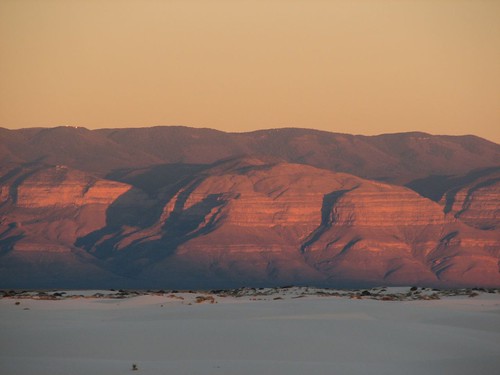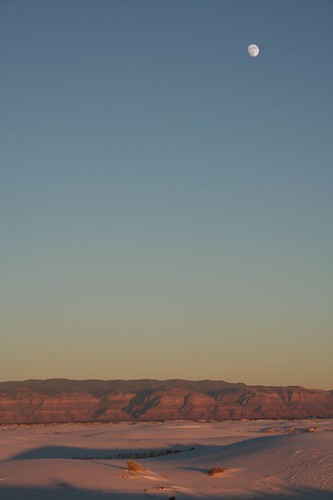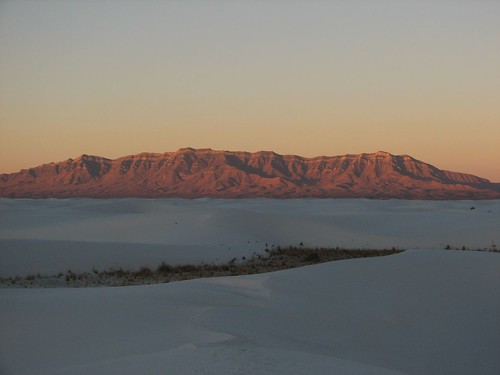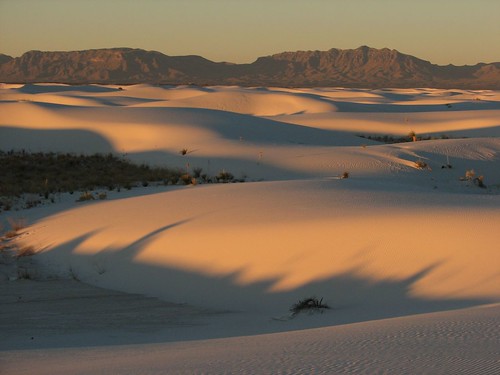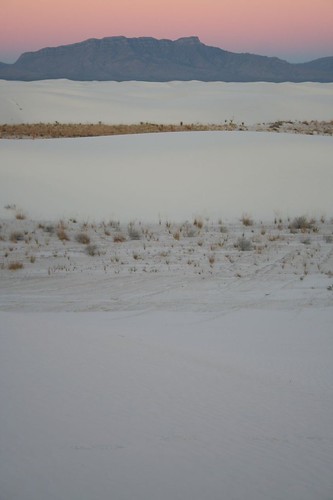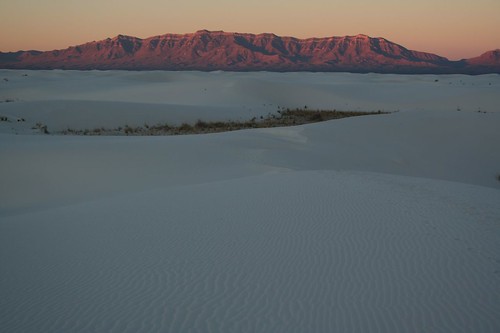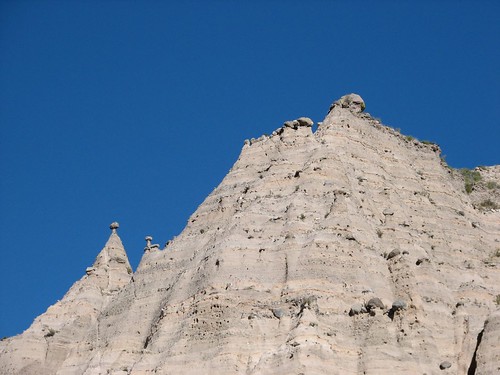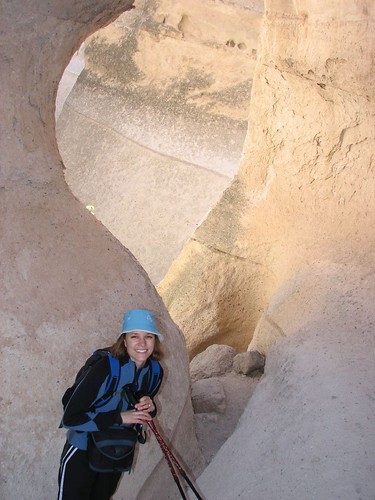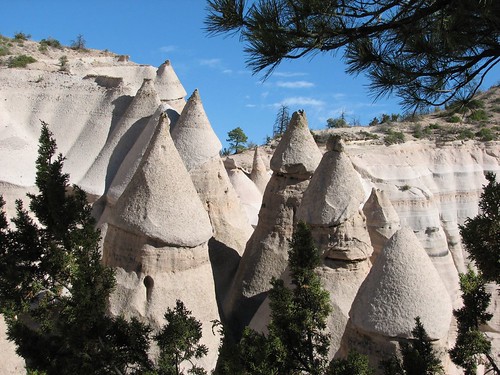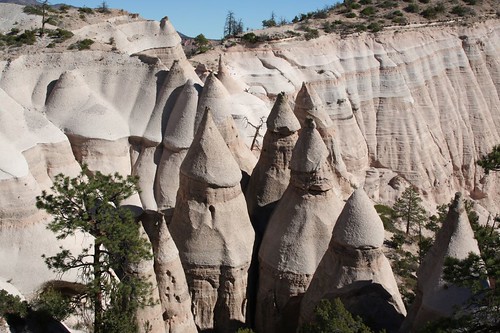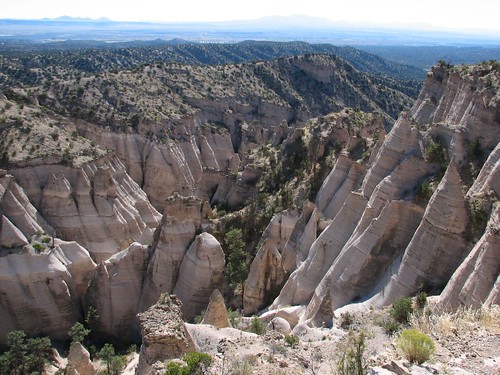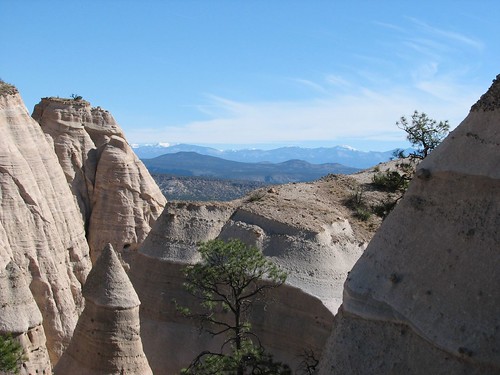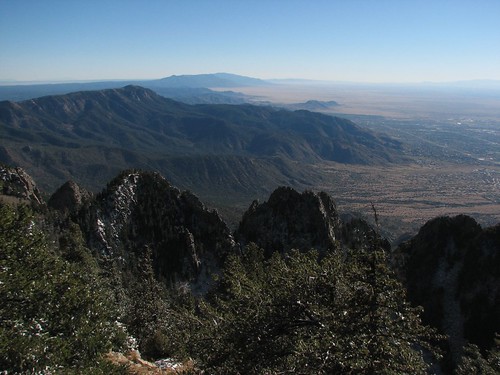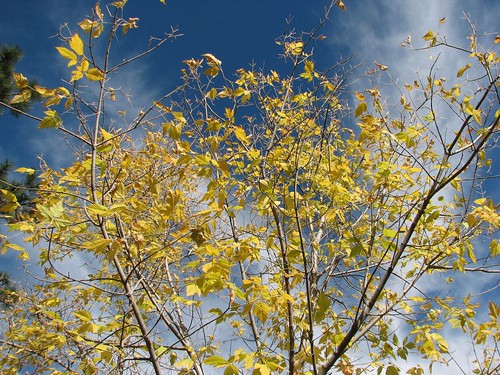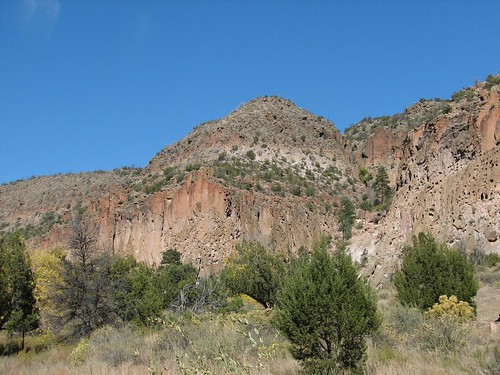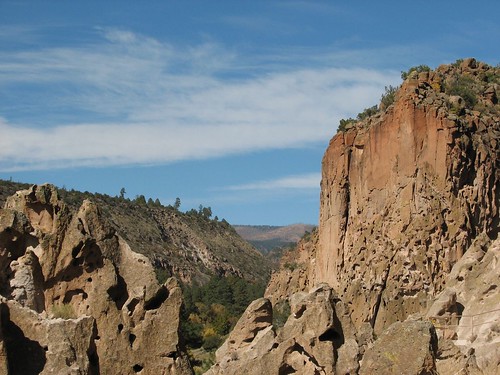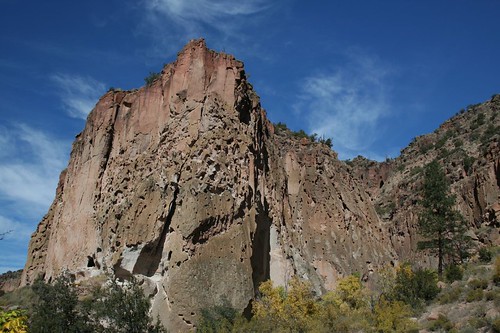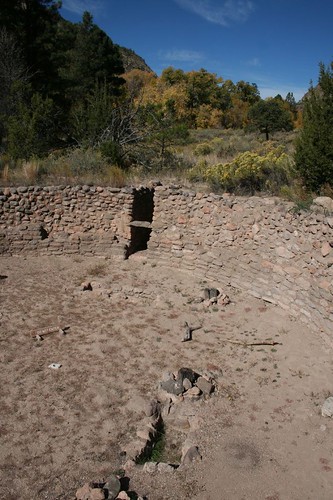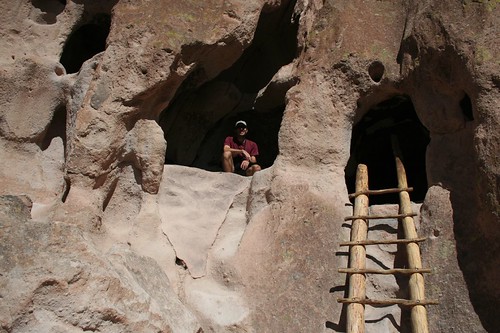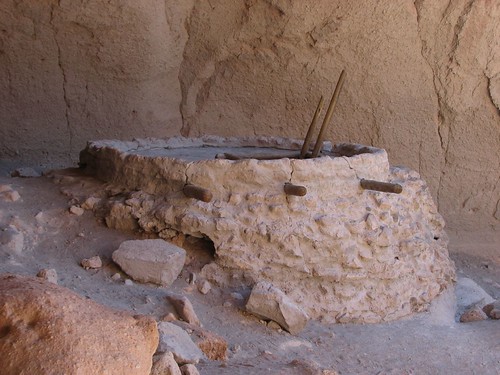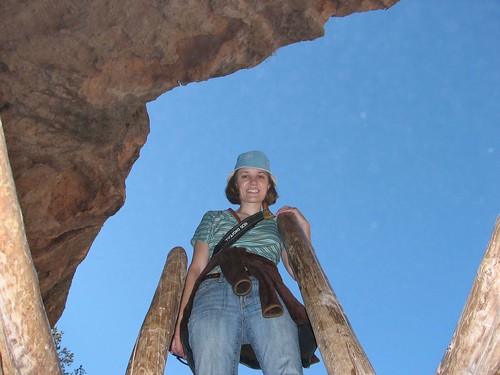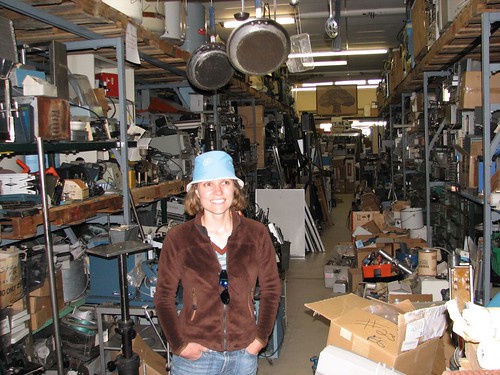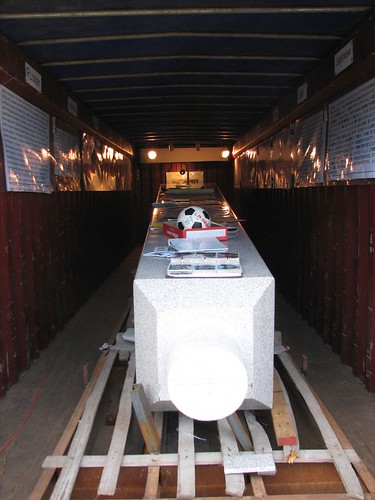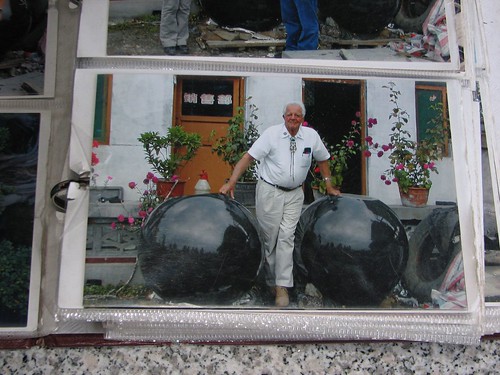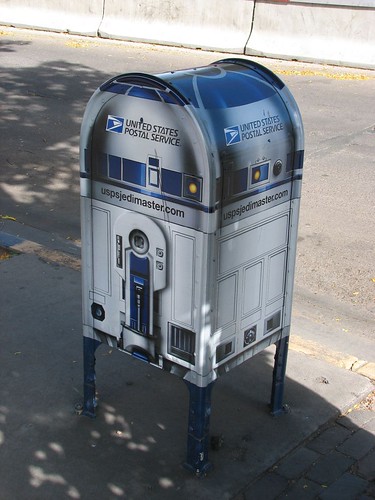Wednesday morning, we woke up in our room in the Silverpick Lodge, looked out the window, and saw snow! An inch or so was on the ground, and it was still snowing – and hard!

We’d definitely chosen the right night to take a break from camping and be pampered in a lodge. We stayed late in bed, both took showers (our second showers in 12 hours!), ate the lodge’s continental breakfast, got back in bed, blogged for a while, asked if we could stay past the 10:00 checkout time, got back in bed, and eventually left a little after noon, refreshed and ready to drive to New Mexico!
We had planned to be in New Mexico on Saturday but got sidetracked by the beauty of southern Colorado. Today, though, we were going to make it. We continued down the highway to Durango for a stop at Serious Texas Barbecue, where we got a half pound of brisket to split. We’d missed real barbecue – yum! The place was all decked out in Texas memorabilia – the best part was the Willie Nelson deer:

The drive to New Mexico started uneventfully, until somewhere along US-64 it started to blizzard. There was snow on the road, we couldn’t see very far ahead of the car, and what was normally a 60+ MPH road became 30. After a while of driving through that, the skies gradually started to clear, and sunset was pretty. We reached the bridge over the Rio Grande Gorge, on the way into Taos, shortly after sunset. It’s the second-highest suspension bridge in the US – here’s the view down into the gorge from the bridge:
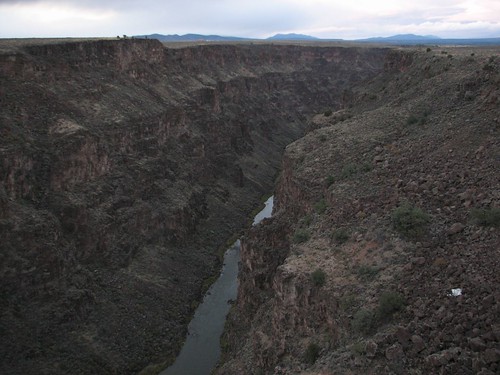
After a quick drive through Taos, we set up camp in the dark at the Rio Bravo Campground in the Orilla Verde Recreation Area south of town, right along the Rio Grande at the bottom of the gorge. We sat up for a little while to make dinner and read – although it was windy and raining, this was a luxurious campground, with covered picnic tables and a sink with hot water to do dishes! It had been a quiet day, but hanging out in the lodge was awfully nice, and tomorrow we’d see Taos!
We woke up the next morning to beautiful morning light in the gorge:
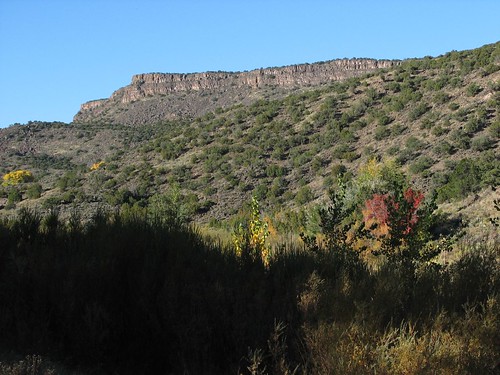

The first stop of the morning was Taos Pueblo. A bit of background here: The Pueblo are a group of Native Americans who populated present-day New Mexico and share some common culture and beliefs but are also divided into 19 separate groups, also called “pueblos”. The word “pueblo” refers to the group of Native Americans as a whole, an individual sub-group, or a town where a sub-group lives. Taos Pueblo is particularly significant because it was a center for resistance to white settlement. In the Pueblo Revolt of 1680, the Pueblo Indians, using Taos Pueblo as their control center, successfully drove the Spanish out of the New Mexico area and back to El Paso – a rare victory in the history of North America’s colonization. Because different Pueblo groups spoke different languages, they learned and used Spanish to communicate amongst themselves. The Spanish stayed away for 12 years but returned in 1692.
Today, the Taos Pueblo village is home to roughly 100 people. Inside the pueblo itself, there’s no running water or electricity, and the adobe buildings are heated with wood fires. The vast majority of the Taos Pueblo tribe, numbering in the thousands, chooses to live outside the pueblo, where there are more modern amenities. But the adobe homes in the pueblo are still passed on from generation to generation and used during ceremonies.
Over 90% of Taos Pueblo people are Catholic, displaying the enduring Spanish influence. Here’s their church, San Geronimo:
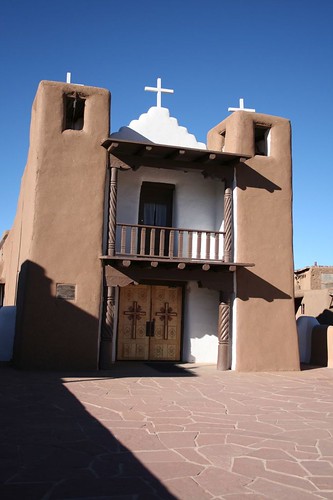
The church was rebuilt after the Americans burned it down around 1850. The U.S. acquired New Mexico, along with much of the Southwest, in the Mexican-American War, and sent a guy named Charles Bent to govern the new territory. Folks in New Mexico weren’t happy about it, and Bent was killed. Taos Pueblo got blamed for the death, and the church was burned with 150 people inside. Here’s what’s left – it was turned into a cemetery after the massacre:

On the north and south sides of the pueblo are two five-story buildings, with smaller homes scattered throughout the rest of the pueblo. The doors and windows are recent additions – in pre-colonial times, for defense reasons, the only entry was through the roof. Ladders would have stood against the walls, all the way up to the top of the fifth story.
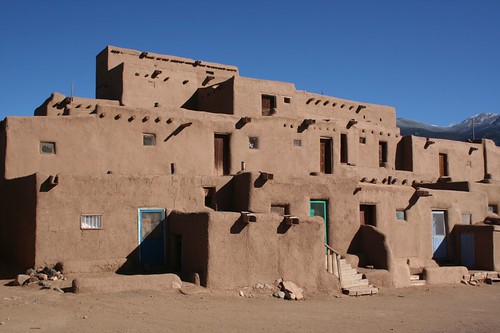
Adobe is a great material for keeping a home cool in the summer and warm in the winter. But it’s high-maintenance – the walls need to be replastered twice a year. Even if they don’t live in the pueblo, the families who own the adobe homes return regularly to perform maintenance on the homes that have been passed down through the generations. Here’s a smaller cluster of homes:

Today, a major source of revenue is the Native American crafts and jewelry industry. Many of the pueblo homes have been converted into galleries selling Pueblo-made products. We especially liked the painted drums:
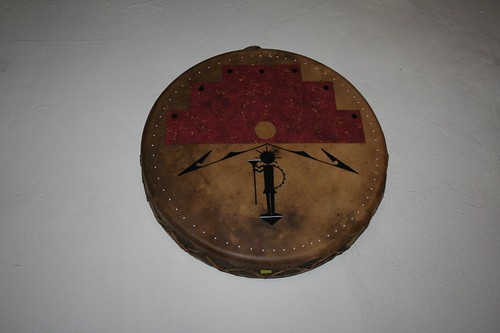
After Taos Pueblo, we did something entirely different. Driving into Taos from the west the previous evening, we had seen mile after mile of orange dirt and sagebrush, and then as we approached Taos we suddenly saw these buildings that looked like they came from outer space. Turns out they’re called Earthships, and they have a visitors center:

The visitors center offered a video and self-guided tour. So we checked it out. Here’s what we learned…
Earthships are self-sustaining houses – “off the grid” was a phrase that was repeatedly used. They generate their own power via solar and wind, and they collect and purify their own water. The water is actually used four times – water used for washing is then used to water in-house greenhouses. After being filtered through the plants in the greenhouse, the water is then used to fill the toilet, and after going through a septic system, that water is then used to water (and fertilize) plants outside.
The buildings are made of used tires packed and surrounded with mud, often with empty cans and bottles. Here’s a case where bottles were used for decoration:

And here’s a photo from the “systems room,” where the home’s high-tech systems are housed. Here the cans are clearly just used for filler:
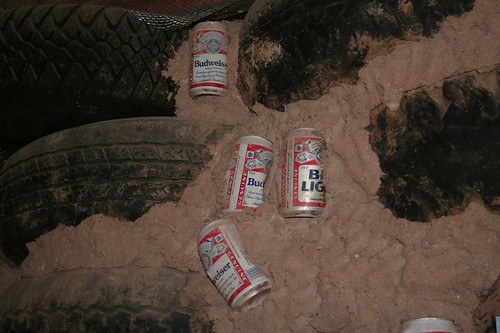
From this picture, you might think that Earthship owners have poor taste in beer. I prefer the more charitable explanation that they’re rabid recyclers and will use whatever materials they can get.
What was most striking about the Earthships was the combination of high-tech and low-tech. The systems room, converting sun and wind to power, is pretty high-tech, but the homes also make use of low-tech environmentally friendly design practices that have been known for centuries but seem to have been all but forgotten these days. For example, the south side of each Earthship features slanted floor-to-ceiling windows, which maximize the light allowed in during the winter and minimize light during the summer, helping maintain a constant temperature. Earth is apparently a great building material, too – it stays at a constant 58 degrees, and the walls of each home are packed very thick with earth, so even in the winter, the indoor temperature doesn’t drop below 58.
An Earthship is more than a home – it’s a way of life. We talked to the woman working in the visitors center for a while. She lives in the community – she worked on building her home from scratch on nights and weekends for six long years. When it still wasn’t anywhere near finished, she hired a couple of people to work with her on it, and two years later it was done. Clearly a labor of love for someone who believes passionately in setting an example for environmental sustainability.
Here’s one more Earthship:
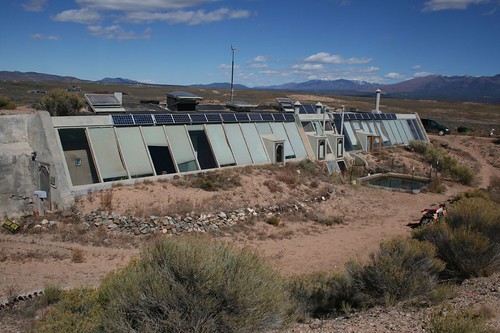
And here’s a photo surveying the community. This particular community has lots for 130 Earthships, and about 50 of those have been purchased:
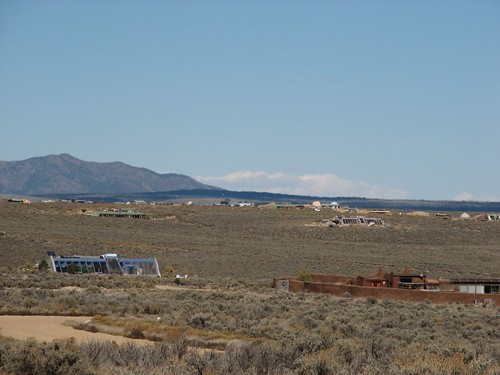
We drove back over the Rio Grande Gorge bridge, this time during the day:

Back in Taos, we did a walking tour of the historic downtown area. Our first stop was the Mabel Dodge Luhan house. She was a wealthy woman from New York who came to New Mexico, fell in love with the area, and attracted artists to Taos.
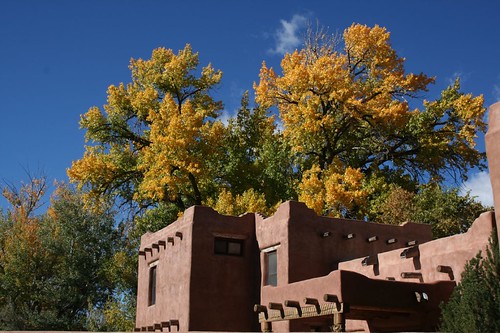
The architecture was an interesting mix of New Mexican and Mediterranean, reflecting Luhan’s varied tastes. And the doors were ridiculously short:
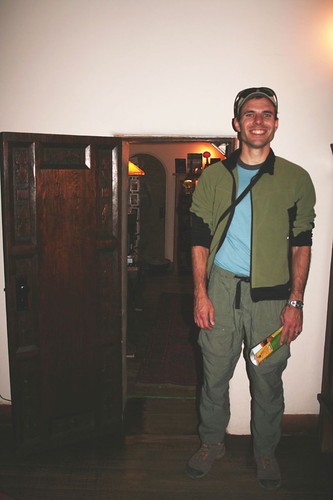
In addition to art and architecture, I guess she liked birds a little bit:
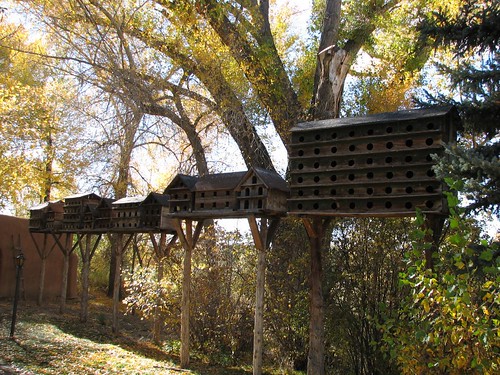
Next we walked down Ledoux Street, home of Taos’s art galleries. We randomly chose Inger Jirby’s gallery and stopped in. The woman working the gallery told us all about the artist, who was born in Sweden but fell in love with New Mexico and settled in Pilar, just south of Taos and coincidentally right next to the campground we were staying at. Jirby did traditional paintings on canvas as well as furniture, walls, and ceilings – in fact, a little hotel next door to the gallery features Jirby’s art in all the rooms.
Just before sunset, we drove a ways up the road to Taos ski area and took some pictures of the dusk light on the mountains:
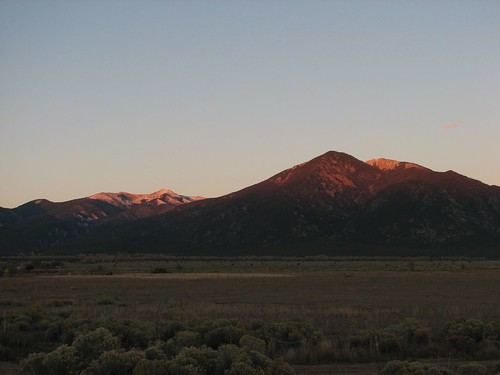
We finished the day with a dinner at Orlando’s called los colores – “the colors” – which was three enchiladas, each topped in a different color of chile.
The next day we drove around the Enchanted Circle, a loop drive starting in Taos that circles Wheeler Peak, at 13,161 feet the highest peak in New Mexico. Our first stop was the D.H. Lawrence Ranch. Lawrence, the author of “Lady Chatterley’s Lover” but also a painter of some really raunchy paintings, tried to start a utopian society in New Mexico. When he sent a call out to all his friends to join him, only an artist named Dorothy Brett signed up. So Lawrence, his wife Frida, and Brett set out for Taos. Mabel Dodge Luhan gave Frida a 160-acre ranch, and the Lawrences and Brett started building their houses on the property.
We were the first visitors that day and saw a large display outside about a disease called hantavirus – apparently, you get it just by breathing in the vicinity of mouse droppings. Then a woman in a nightgown, jeans, and bare feet came out of a building next to the parking lot. She told us that the hantavirus display was a load of crap and that as long as we weren’t crawling around on our hands and knees sniffing mouse crap, we’d be fine. The ranch is administered by the University of New Mexico now, and some overzealous students put up the display, she said scornfully.
She asked if we were fans of Lawrence, and we said no, we were just curious. We’d read about some competition between Frida, Brett, and Luhan for Lawrence’s attentions, so we asked about that. She said there was no such competition – the three women got along great, and only Brett was really enamored with Lawrence. After all, she said, Lawrence had some sexual performance problems – why would women fight over him? We thanked her for this information and headed out on the self-guided tour.
We found a tree that’s apparently famous because Georgia O’Keefe looked up at it and decided she had to paint it. Her painting is at night, with the stars shining through the branches, but we took our picture in the morning:
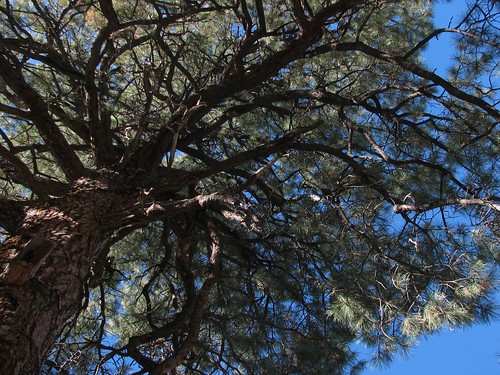
When Lawrence died, Frida had him cremated and brought his ashes back to spread at the ranch. As the story goes, Brett and Luhan showed up uninvited, and Frida threw the ashes into a wheelbarrow of wet cement, saying, “Let’s see them try to steal this!” The cement was then turned into Lawrence’s memorial:

After this, we drove to the Wild Rivers Recreation Area, which contains the confluence of the Red and Rio Grande rivers. We did the hike called La Junta, a short but steep trail that leads right down to where the two rivers join.
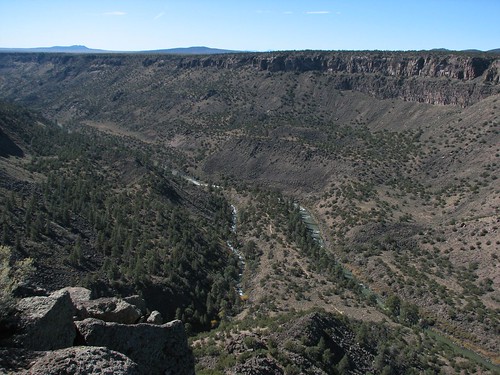
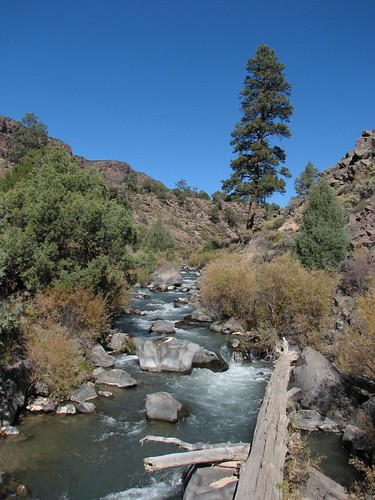
At the bottom, we stopped to take a picture with the Rio Grande as our backdrop:
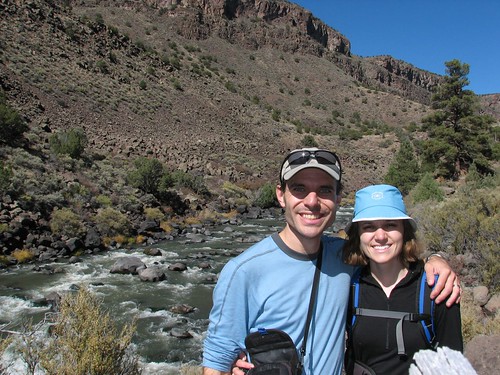
We saw several lizards along the trail:
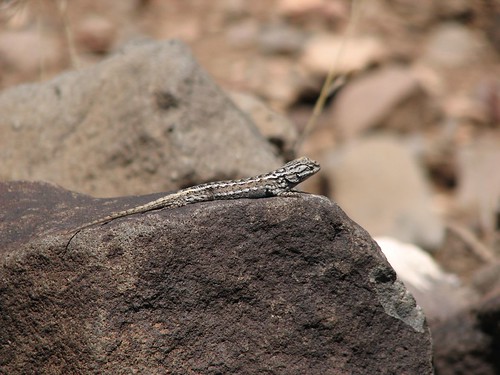
Then we did another hike called Big Arsenic, a slightly less steep path down to the Rio Grande upstream of the confluence.
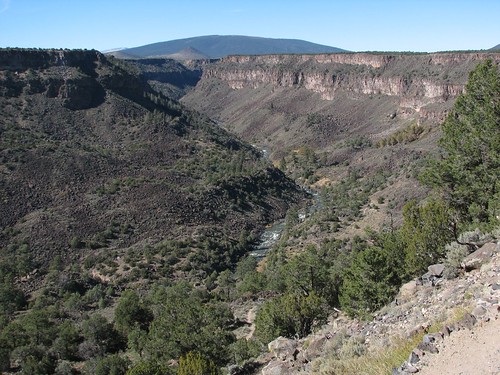
There are supposedly a lot of Native American petroglyphs and pictographs on the boulders at the bottom of the hike, along the river. We found a few:
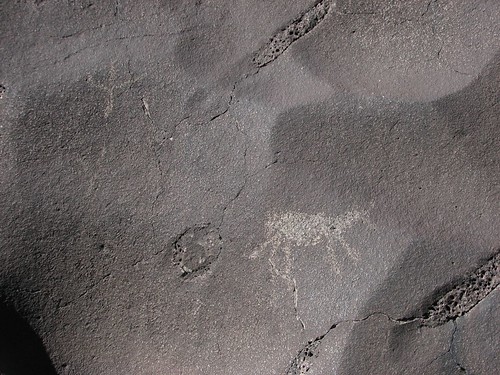
We were starting to drag a bit as we hiked up and out. The hike, while beautiful, was hot and dry – very different from hiking in the Pacific Northwest, and very different from the cold, snowy weather we’d gotten used to in Colorado. We started talking about ice cream – boy, did that sound good. Unfortunately, there was no ice cream in the car, so when we got back to the trailhead, we mixed some powdered hummus and water and had hummus on pitas and some fruit for lunch. Re-energized, we were ready to continue along the Enchanted Circle.
The drive afforded some pretty views:

And there was this one lone flower that seemed awfully out of place:
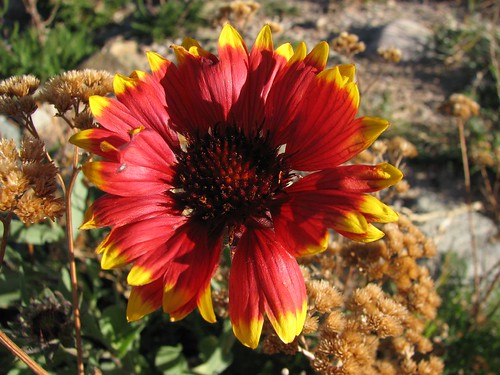
And we did buy a pint of Ben and Jerry’s ice cream at a small grocery store somewhere along the way. Triple Caramel or something like that – it hit the spot! After driving the Enchanted Circle, we headed back to our campsite at the Orilla Verde Recreation Area for the third night. The campground hosts must have thought we were weird – every day, we took down our tent and packed up, and each night, we came back. We weren’t necessarily planning to stay each day – in the morning on this day, for instance, we thought we might stay somewhere along the Enchanted Circle or we might come back to Orilla Verde, so we packed up just in case.
Rivaling the views of the Red and Rio Grande and the pint of Ben and Jerry’s for the top moment of the day: We got showers! Our first night at the Rio Bravo campground, we rejoiced when we noticed showers in the bathrooms, and on our second morning there, we dug out soap, shampoo and towels from our car and headed to the bathroom. Only then did we realize that the showers were coin-operated – four quarters for three minutes. We had only two quarters in the car. A crushing disappointment!
So when we bought the ice cream, we exchanged dollars for quarters, and that night, we took our first showers since the lodge. Brian splurged and bought six minutes of water, while Sarah set a world shower record at only three minutes – or really, more like 1.5 minutes since the first half minute was lost waiting for the water to warm up, and she finished quickly, not wanting the water to run out while she was soaped up. Even though the water started cold and our time was limited, it was extremely satisfying.
The next day, Saturday, October 20, we would drive to Santa Fe!
